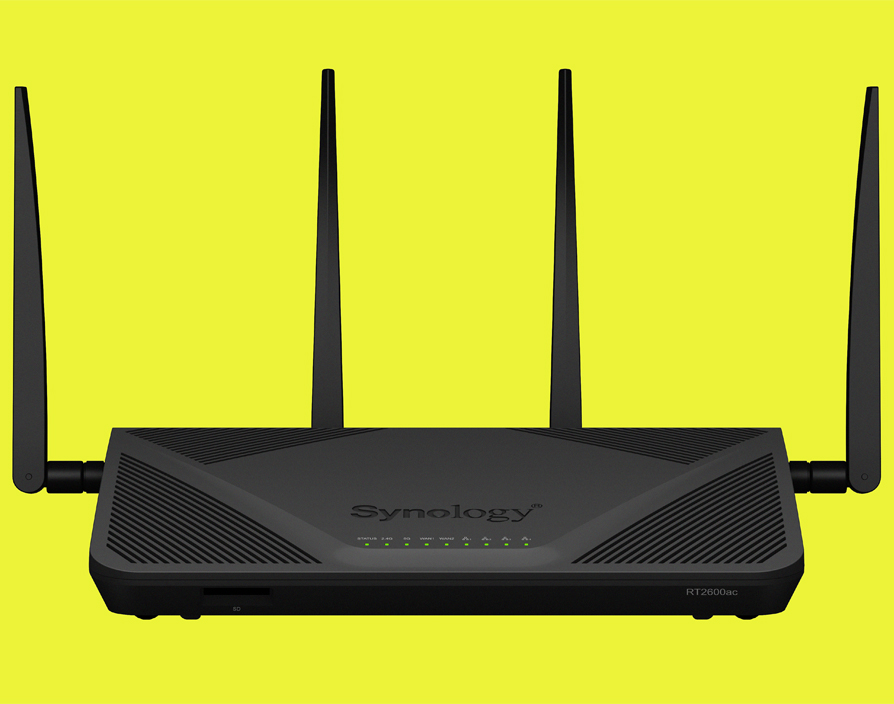With a crown of antennas and diagonal vents akin to a TIE Fighter from Star Wars, Synology’s RT2600ac looks and feels like a piece of alien technology. But can it run internet speeds like something out of this world as well as its looks suggest?
Everyone knows modern businesses and homes alike can’t function without the internet – but just having the minimum is no longer good enough. Digital streaming services like YouTube now offer 8K-resolution videos and offices can see dozens of simultaneous calls across the cloud. The need for speed is certainly there for consumers and companies alike.
And, luckily, internet service providers like Virgin Media are doing what they can to meet the demand, offering connections as fast as 362 megabits per second (Mbps) of download speed.
However, your provider can be as fast as they like – it still won’t do you any good if your router sucks. Even the best download and upload speeds will be completely wasted if it’s not geared up to handle it. To accommodate this demand, manufacturers like NetGear and Synology are releasing powerful yet relatively affordable routers aimed at remote workers, entrepreneurs working from home and small offices – almost all of which look like small angry space ships..
One of those is Synology’s RT2600ac router. On paper, it’s more than capable of running just about anything the average person needs. Its 1.7GHz dual-core processor and four antennas combine to boast a wireless speed of 800Mbps and 1733Mbps on the 2.4GHz and 5GHz radios respectively. To put that in perspective, Netflix recommends a minimum of 25Mbps for ultra HD quality.
It also comes complete with a variety of external ports around the back including a USB 3.0, USB 2.0 and SD card slots. Moreover, it has one combined WAN and LAN port as well as three LAN ports.
It’s clearly meant to shine handling dozens of connections with simultaneous downloads in an office environment. Admittedly, this is a far cry from the one or two people we had as guinea pigs. But nonetheless, after hooking this router up with a relatively modest 63Mbps max download speed and putting it through some stress tests, some interesting things happened.
The range of my ISP’s bog-standard router – as well as the odd shape of my house – means it never covers the entire building. Annoyingly, this requires repositioning my router to either play Netflix upstairs or PlayStation 4 downstairs with an acceptable 40Mbps. But after plugging in the RT2600ac, my iPhone snapped on to the wifi as soon as I found myself walking up the road about 30 metres away from the house.
Although at that distance the signal was just enough to receive emails, roughly ten metres on I was enjoying my usual 40Mbps despite various buildings being in the way. In the house itself, the phone nearly reached the maximum 63Mbps allotment for the first time ever – and I can blame not getting a few more megabits from the router on factors outside its control.
The numbers looked good so the next natural test was to render a 8K-montage of Peruvian landscapes on YouTube. While before one frame of a canoe floating down a river barely reached my laptop’s screen, the RT2600ac effortlessly helped my device play it in its full glory.
I can’t get enough of Peru so in an attempt to simulate a bustling office environment with intense internet usage occurring left, right and centre, I played the same 8K-footage across a tablet, PC, PS4 and two smartphones at the same time, which my 63Mbps internet limit didn’t like at all. But after shutting down half the devices Peru cruised by them all smoothly – aside from forgivably occasional choppiness on the mobiles and slightly longer loading times.
It seems the RT2600ac will squeeze everything it can out of the average remote worker or micro-business’ internet allowance. Does this warrant the £200 price tag? That depends on your allowance. If you’re pushing an average speed of 20Mbps, you won’t notice the greatest difference. However, if you want that consistently available across a 20 to 30 meter radius, perhaps spanning multiple floors and the room to one day expand, you won’t be disappointed. ![]()
Share via:








































